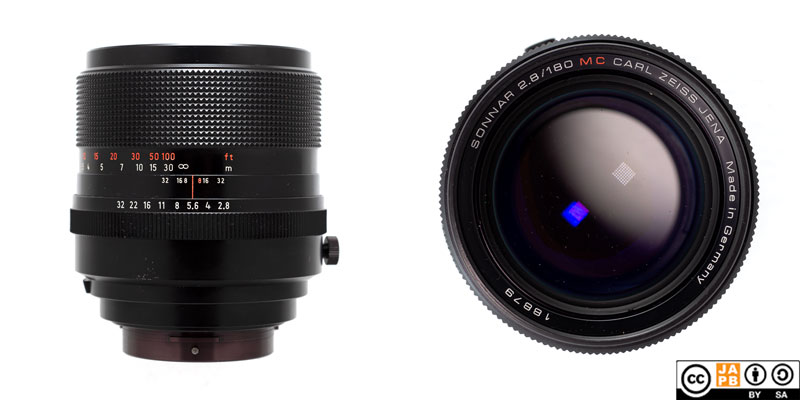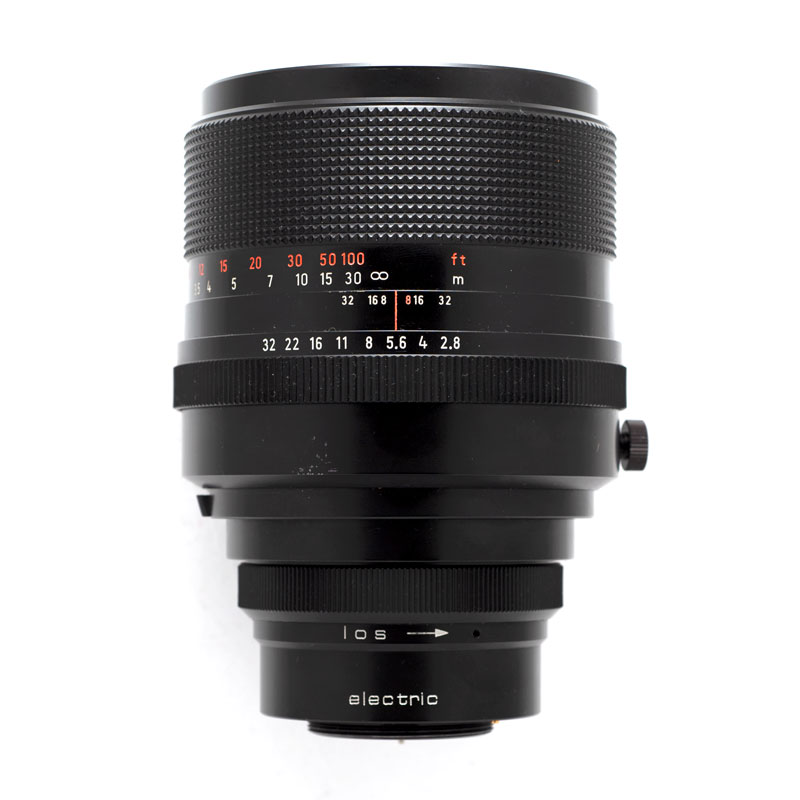Pekka Buttler, 07/2023

Specifications
The table below summarizes the lens’ key specifications (measurements based on pictured lens):
| Brand: | Carl Zeiss Jena | Lens name | Sonnar 2.8/180 MC |
| Focal length(s) 1 | 180 mm | Angle-of-view 2 | 25 ° (on medium format) ≈12 ° (on ‘full frame’) |
| Maximum Aperture | f/2.8 | In Production | 1936–≈1991 (all variants) ≈1973–1991 (this variant) |
| Lens mounts | Pentacon 6 (native) m42, Praktica B (using factory adapters) | Subfamily (if applicable) | –– |
| Length 3 | 106,8 mm | Diameter 4 | 102,2 mm |
| Filter ring diameter | 87 mm | Weight | 1300 grams |
| Lens element count | 5 | Lens group count | 3 |
| Aperture blades (S/R/C) 5 | 7 S 6 | Focus throw | 180 ° |
| Minimum focusing distance | 1,7 m | Maximum magnification | 1:7,3 |
| Has manual aperture ring | YES | Has Manual focus ring | YES |
| Aperture mechanism type | Automatic | Aperture click stops 7 | 2.8•4•5.6•8•11•16•22•32 |
Further notes:
• The 180 mm f/2.8 Sonnar was originally introduced in 1936, and is known as the ‘Olympia Sonnar’ because of the prominent role it played in photographing the 1936 olympics.
• Throughout the 50+ years of its production run, the same basic optical recipe has been offered in many outwardly and mechanically different casings.
• The pictured sample is from the 1990s (based on ‘Made in Germany’), and likely is among the last samples ever manufactured according to East German designs.
• The ‘native’ mount of this lens is the medium format Pentacon 6 mount, but it seems that this was on Carl Zeiss Jena’s part a double play: certainly the lens could be used on Pentacon 6 cameras, but the Pentacon 6 mount was also used as an intermediate mount because it allowed CZJ to offer the lens with a broad range of adapters to various 35 mm format mounts (pictured below with an adapter to the electric version of the m42 mount). Importantly, factory-supplied adapters were designed not only to allow mounting, but to allow native-level use (the pictured m42 electric adapter facilitates automatic aperture stop-down and electronic transmission of selected aperture).
• The factory adapters offered were somewhat dependent on the era of the lens (1960s samples were offered with adapters for m42, Exakta or Praktina, etc.)
• Importantly, many of the earliest samples are single-mount versions (including Contax/Kiev, Exakta, Praktiflex) and were not intended to be used with adapters on a range of systems.
History of Carl Zeiss Jena
There are few names in camera optics more illustrious than that of Carl Zeiss. The company was founded in the German town of Jena in 1846 by Carl Zeiß (hence: ‘Carl Zeiss Jena‘). During 1846–1945 there are few major developments in lens optics that the company was not involved in. Names that are even today well-known in optics – such as Planar (1896), Tessar (1902), Sonnar (1929), and Biotar (1939) (as well as many names that only optics-buffs know) – were the product of Zeiss’ first century of technological innovation.
After the Second World War Germany was divided into a Soviet zone (subsequently: East Germany) and the west-allied zones (subsequently: West Germany). While the Zeiss works resided in Jena (optics and glasses) and Dresden (cameras), which were in the Soviet sector, a contingent of Zeiss managers decided to move west and ended up setiting up shop in the small town of Oberkochen in the American sector under the name of Opton Optische Werke Oberkochen GmbH 8. As the relations between the former allied deteriorated and the split into East and West Germany became all the more real, the Oberkochen works changed their name first to Zeiss-Opton and later to Carl Zeiss.
What ensued was a lengthy international trademark dispute with both Zeiss’ (Jena and Oberkochen) laying claim to the name ‘Carl Zeiss’. The resulting stalemate – emblematic of the Cold War in its entirety – resulted in that Carl Zeiss Opton was allowed to use the name Carl Zeiss in the West, but had to use the Opton brand in the East bloc, whereas Carl Zeiss Jena was the only real Carl Zeiss as far as the east bloc was concerned, but could – mostly – not use the Carl Zeiss -name for exports to the West. The fact remains however, that – starting in 1946 from a shared base – Jena and Oberkochen developed as two independent companies for more than 40 years. During the entire Cold War period, VEB Carl Zeiss Jena was seen by the country’s leadership both as a paragon of the East German technology industry and a showcase of the socialist/communist system as well as a major source of exports (and hence, western currencies). Within the centrally directed economy’s hierarchy, Carl Zeiss Jena therefore had a more prestigious role than other East German optics manufacturers (prominently Meyer-Optik Görlitz and, later, Pentacon), meaning that Carl Zeiss Jena received privileged access to tools and materiel (including the first computer in East Germany) and that its products were always considered the premium alternative.
After German reunification also Zeiss East and Zeiss West were united again, and have since again been at the undoubtable forefront of lens development. Even though it was manufactured after reunification, this lens sample harkens to the time of the cold-war and the East/West split.
History of the Sonnar designs
The Sonnar designs were originally born out of necessity. Back before the invention of lens coating technology, each air-glass boundary represented a serious problem. Every air-glass boundary meant roughly 5% of the light that would hit such a boundary would be bounced back, instead of passing through the boundary. This not only meant that each air-glass boundary would decrease the amount of light that passed through the lens to the film plane, a goodly portion of that reflected light was liable to be bounced around within the lens, leading to veiling flare and loss of contrast. Hence, design a lens to minimise the number of lens groups was crucially important.
Until the invention of the Sonnar design, the only ways to produce large aperture lenses were based on the double-Gauss (a.k.a. Planar) and Ernostar designs, both of which were hampered by that the number of air-glass boundaries were relatively high (a minimum of 8). The Ernostar was the 1924 creation of the young (then only 23 years old) lens designer Ludwig Bertele for the company Ernemann. At the time of its launch it was – at f/2 – the fastest still camera lens in existence, and one year later Bertele bested his previous record with the f/1.8 Ernostar.
After Carl Zeiss acquired Ernemann in 1926, Ludwig Bertele continued pushing the boundaries and the Sonnar was a further development of the Ernostar. Not only did the Sonnar in 1932 manage to achieve an even larger maximum aperture (at f/1.5), it did so while simultaneously decreasing the number of lens groups to 3 (hence decreasing the number of air-glass boundaries to 6). It seemed like the perfect solution.
But it did not last long, Sonnar designs for standard lenses would never work on SLR cameras (that necessitated a significant back focal distance). Moreover, as lens coating technology advanced, one primary requirement for Sonnar-type lenses evaporated. After the war, Sonnar lenses remained popular on rangefinders (both as standard lenses and as short tele lenses), but after the advent of SLRs, Sonnar typed designs were reserved largely for large-aperture tele lenses, such as this ‘Olympia Sonnar’ as well as many other wide aperture tele lenses.
Versions
During its 50+ years of remaining in construction, the Olympia Sonnar was offered for a multitude of camera systems in formats ranging from 16 mm motion picture film to medium format. Moreover, development was continuous, leading to that there is a truly mind-boggling number of versions and variants in existence.
Adapting
If you’ve come into possession of this lens, your sample will either offer its native Pentacon 6 mount, or come with one (or more) adapters attached. Here I will discuss adapting the lens in Pentacon 6 mount. If your lens comes with an adapter, refer to the JAPB article on that lens mount (likely candidates: Exakta, m42, Praktica B, Praktina)
The Pentacon 6 mount offers a wide range of alternatives for adapting.

To use this lens natively, you will need a Pentacon 6 mount film body. In practical terms this means either a Praktisix or Pentacon Six medium format film camera or a Kiev 60/6C medium format film camera. While neither of these families of bodies were manufactured in their millions, they remain readily available, and even serviceable.
Thanks to the generous image circle Pentacon 6 lenses offer, and thanks to the copious flange focal distance (74,1 mm) of the Pentacon 6 system, this lens can be adapted to every full frame (and smaller) SLR, dSLR and mirrorless camera assuming a suitable adapter can be found or manufactured. Moreover, Pentacon 6 lenses are so uncomplicated that a simple ‘dumb adapter’ will do the job perfectly.
Thanks to the generous image circle, Pentacon 6 lenses have also long been a strong candidate to be used on smaller formats (full frame and smaller) in conjunction with tilt/shift adapters. Alternatively, one can choose to daisy-chain adapters (e.g. Pentacon 6->Canon EF; Canon EF –> mirrorless) which not only broadens the range of available adapters, but also allows using speed boosters for those photographers that use smaller than full-frame sensors.
Finally, regarding larger than full frame, there are also options. Digital medium format is perfectly usable (assuming adapter availability) and many 6×4,5 film formats are likewise theoretical possibilities, but gaining functional adapters may necessitate some DIY.
Footnotes
- Focal length is (unless stated otherwise) given in absolute terms, and not in Full-frame equivalent. For an understanding of whether the lens is wide/tele, see ‘Angle-of-view’. ↩︎
- Picture angle is given in degrees (based on manufacturers’ specs) and concerns the diagonal picture angle. Rule of thumb:
> 90 ° ==> Ultra-wide-angle
70–90 ° ==> Wide-angle
50–70 ° ==> Moderate wide-angle
40–50 ° ==> ‘Standard’ or ‘normal’ lens
20–40 ° ==> Short tele lens
10-20 ° ==> Tele lens
5-10 ° ==> Long tele lens
< 5 ° ==> Ultra-tele lens ↩︎ - Length is given from the mount flange to the front of lens at infinity. ↩︎
- Diameter excludes protrusions such as rabbit ears or stop-down levers. ↩︎
- S=straight; R=rounded; C=(almost)circular at all apertures. ↩︎
- This, late, version of the Olympia Sonnar uses a 7-blade automatic aperture design (ASB or Automatische Springblende, in German), but earlier manual and preset versions used setups offering up to 18 blades. ↩︎
- Numbers equal aperture values on aperture ring; • intermediate click; – no intermediate click. ↩︎
- Online one can find many lengthy and heated disputes stating that only Jena/Oberkochen is the true Carl Zeiss. While many of these discussions are riddled with misconceptions and a poor grasp of facts and timings, they largely also tend to be tainted by ideologies. Those discussions that focus on claims of one or the other Zeiss not really having rights to using designs developed at pre-war Zeiss are especially ludicrous because after the war practically the entire patent catalogue of pre-war German patents was given freely to everyone (the allied saw this as a form of reparations), hence also kickstarting the Japanese optics industry’s ascendancy (the Japanese optics companies were the most avid users of German optics patents). ↩︎